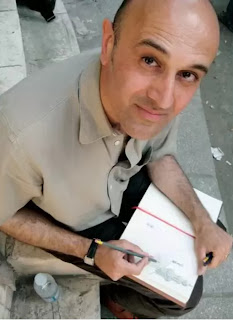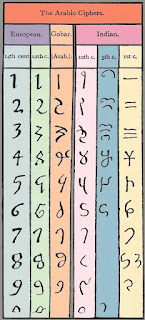University of Surrey professor Jim Al-Khalili has made a BBC documentary, Science and Islam. He says that there are still many Arabic references in modern science.
"During the 12th to 17th centuries, European scholars regularly referred to Islamic writings of the past."
Evidence of this can be found in the famous book on the account of Leonardo of Pisa, known as Fibonacci. He is the first great mathematician in Europe.
Al-Khalili says that on page 406 of this book, the Arabic name "Muhammad" is written in Latin style.
This is a reference to Muhammad ibn Musa al-Khwarizmi, who lived between 780 and 850.
Khwarizmi is the man who came up with a revolutionary idea in mathematics that you can express any number with just 10 simple letters.
He left East Persia and took refuge in Baghdad, and he has the honor of giving the Western world a decimal and numerical system. He is often referred to as the "Father of Algebra".
 |
| Al-Khalili has made a documentary called Science and Islam |
John Joseph of St. Andrews University in the UK says there are many ideas that were considered the services of European mathematicians during the 16th, 17th and 18th centuries but in fact Arabic or Islamic mathematicians came up with similar ideas four centuries ago. Were
"The mathematics we study today is closer to Arabic or Islamic services than the Greeks."
Many such great mathematicians have been born in the history of the Arab and Islamic world. The following are three such names.
Jabir bin Sanan al-Batani
Juan Casada, a former professor and retired professor of Arabic and Islamic studies at the University of Madrid, says one of the great services of Arab mathematicians was to preserve Greek and Latin sciences through translation. And he took the scientific discoveries of the Indians further.
Speaking to BBC Mando, Huan Kasada said: "The significance of Albatani is that he combined astronomy and mathematics and made it a single discipline."
He applied mathematical formulas to astronomy. For example, he skillfully determined that there are 365 days in a solar year, which was a great achievement. "We are talking about the end of the ninth century and the beginning of the tenth century."
"By studying the information from the movement of the sun, they discovered that there were errors in Ptolemy's research, and thus the Arabic mathematicians corrected Ptolemy's Greek heritage."
Al-Khalili visited the University of Padua in Italy and found one of the most important books in the history of science written by Nicolas Copernicus.
This book is very important. Contrary to ancient Greek belief, Copernicus argued that all the planets, including the earth, revolve around the sun.
"Many historians call him the inventor of the scientific revolution in Europe."
"It simply came to our notice then.
Al-Battani was born in Syria near Orfa in 858 and died in Iraq in 929. Copernicus used Albatani's observations to explain the existence of planets, the sun, the moon and the stars.
Ibn al-Shater was an astronomer and mathematician who was born in Damascus around 1304, Jamie Cordero, a professor of Arabic and Islamic studies at the University of Salamanca in Spain, told the BBC. "He is rarely recognized in the West because his work was not translated into Latin."
However, he says that during the 1980's, researchers discovered a model of the planet Al-Shater and realized that it was the same model that Copernicus proposed a few centuries later.
Ibn al-Haytham
Sheikh Mohammad Razaullah Ansari, a professor of physics at Aligarh Muslim University in India, wrote an article for the UNESCO website. In it he tells of an Arab scholar of the 10th and 11th centuries who devoted his life not only to mathematics but also to physics, mechanics, astronomy, philosophy and medicine.
He was referring to the great scientist Abu Ali al-Hasan ibn al-Haytham al-Basri, who is also called al-Haysan in the West or Al-Haysan in Spanish.
He was born in Iraq in 965 and died in Egypt in 1040. He is one of the leading scientists in Cairo, also known as Ptolemy II of Arab Scholars.
He is considered to be the founder of modern scientific style. Razaullah Ansari says he devised an experimental method to test a basic hypothesis. Cassada says he has done a lot of service in various fields.
According to Ansari, his famous book "Fi Al-Manazer" was translated into Latin during the 12th and 13th centuries. There are seven volumes of this book in which he gives information on the properties of light with the help of experiment and mathematics.
Ricardo Moreno, a professor of mathematics at the University of Madrid, describes him as a great mathematician. He was one of the first Arabic mathematicians to teach solving big questions. He answered one third of the questions with the help of numbers. These are the questions that Archimedes asked more than 1,200 years ago.
Al-Haytham did a great job in the field of number theory and important numbers in the field of numbers. And he researched specific questions of Euclid's theorem.
Abu Kamil Al-Hasib
Ricardo Moreno states that after the death of Khawarizmi, Abu Kamil Shuja ibn Aslam ibn Muhammad ibn Shuja al-Hasib, also known as the "Egyptian calculator", was born in Egypt.
During his 80 years of life, he performed numerous services in mathematics. These include his research into algebra, which lost its original Arabic form. But two translations into Latin and Hebrew are still available.
According to his short biography, very little is known about the life of Abu Kamil. But he has played a significant role in the study of algebra. He is considered the successor of Khwarizmi in this field. Kamil himself calls al-Khwarizmi the founder of algebra.
However, the importance of Abu Kamil's work is even greater. Fibonacci books are based on this work. "Perfect was not only important in the development of Arabic algebra, but he also introduced algebra to Europe through Fibonacci."









0 Comments